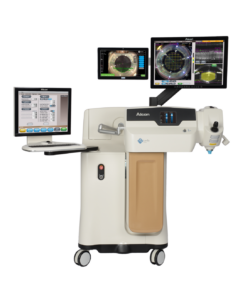 By Nancy A. Balin, M.D., F.A.C.S.
By Nancy A. Balin, M.D., F.A.C.S.
I’ve had quite a few patients asking me about laser-assisted cataract surgery lately. They’ve heard about it from friends, seen something about it in articles or advertisements, and they want to know more about its benefits, risks, and whether it’s all worthwhile. I thought I would share some of what I discuss with patients about this technology to help shed some light on the subject.
WHAT IS LASER-ASSISTED CATARACT SURGERY?
Laser-Assisted Cataract Surgery involves the use of a Femtosecond laser for three crucial parts of the cataract surgery process: the corneal incision, pre-softening of the lens, and the capsulotomy. It can also be used to reduce corneal astigmatism up to 1 diopter.
IS IT AN IMPROVEMENT?
The Corneal Incision:
The way a corneal incision is traditionally made is with a diamond-tipped blade. I still perform many cataract surgeries this way, with a great rate of success; however, there are benefits to using the laser for this purpose. First, accuracy and precision: the laser performs the incision with real-time imaging that results in consistency and precision that is unmatched even by the very best surgeons. Second, the laser applies far less pressure to the eye than a scalpel, resulting in less trauma and lessening the risk surgically induced astigmatism.
Pre-Softening of the Lens:
As cataracts develop, they also harden. Traditionally, I will use a device to break the lens up into smaller pieces using ultrasound prior to removing it from the eye. The denser and harder the cataract, the more ultrasound energy is required, creating a risk of damage leading to swelling and clouding of the cornea that can increase heal time. Using the Femtosecond Laser to pre-soften the lens, I can use less ultrasound and minimize trauma.
Capsulotomy:
Your natural lens is held within a thin, delicate membrane called the “capsule.” I need to remove the central part of the capsule to reach and remove the lens inside. The capsule then contains and helps position the intraocular lens implant. Traditionally, I will perform the capsulotomy manually using a metal needle and micro-forceps. Using the image-guided Femtosecond Laser results in more precise, reproducible results, and studies show that this method reduces rates of capsular tearing and complications during the capsulotomy.
Astigmatism Correction:
In some cases, I can also use the Femtosecond Laser to reduce corneal astigmatism. While in many cases I will recommend a “toric” intraocular lens implant to correct for astigmatism, I can also achieve up to 1 diopter of astigmatism correction using a technique called limbal relaxing incision (LRI) using the Femtosecond Laser.
ARE THERE RISKS TO LASER-ASSISTED TECHNOLOGY?
There are risks associated with any surgery and with all surgical techniques. That said, Laser-Assisted Cataract is considered quite safe. One big consideration is whether a patient has had laser vision correction in the past. If so, there is some risk that the suction involved in using the Femtosecond laser could cause some complications. For this reason, I will sometimes opt not to perform Laser-Assisted Cataract Surgery on patients who have had laser vision correction in the past—however, this decision is made very much on a patient-by-patient basis.
DOES LASER-ASSISTED CATARACT SURGERY COST MORE?
Yes. The additional cost of using the Femtosecond Laser is not covered by insurance and does result in additional out-of-pocket expenses for the patient. At Balin Eye & Laser Center we have financing options available that can help make these costs more manageable. We will be happy to discuss this with you at your cataract consultation.
WHAT’S THE BOTTOM LINE? SHOULD I OPT FOR LASER-ASSISTED OR NOT?
My staff and I always strive to inform you as thoroughly as possible regarding the benefits and risks of the options available to you. The choice is ultimately yours. I’ve been performing manual cataract surgery for decades with a very consistent history of positive results. Technology continues to advance, and as it does, I will continue to evolve my approach along with the latest techniques, technologies, and equipment. It is accurate to say that, statistically speaking, Laser-Assisted cataract surgery provides increased precision and results in a higher rate of reproducible results, less trauma to the eye, a lower rate of complications during the capsulotomy, clearer corneas, and more rapid recovery. Correction of up to one diopter of astigmatism with the laser is an additional benefit. Ultimately, there is no “right” or “wrong” choice, as long as your cataract surgery is being performed by a qualified surgeon. I encourage you to speak with me and my surgical coordinators to help you with your decision.



